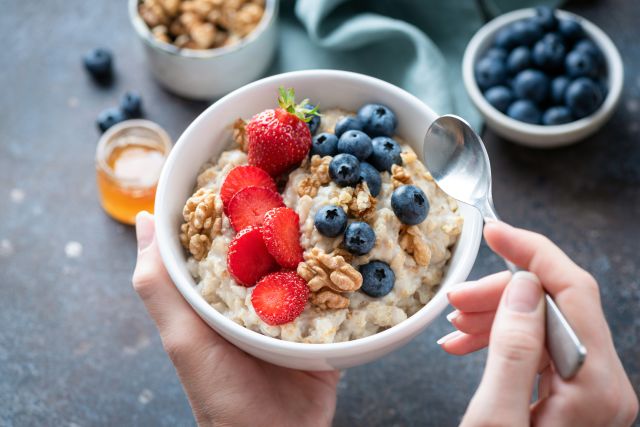Updated on June 29, 2023.
What comes to mind when you think of warm oatmeal, fresh strawberries, or crunchy celery? If blood sugar and cholesterol levels weren’t the first things that occurred to you, that’s understandable.
The fact is, though, that foods high in soluble fiber (such as fresh fruits, vegetables, legumes, and whole grains) can help decrease after-meal blood sugar and cholesterol levels. To learn how to lower your blood sugar and levels of low-density lipoprotein (aka, LDL, or “bad cholesterol), grab a crunchy carrot and read on.
How soluble fiber helps blood sugar
When it comes to dietary fiber, there are two types: soluble and insoluble.
Soluble fiber dissolves in your stomach to form a gooey, gel-like substance, while insoluble fiber stays relatively intact during its trip through your digestive system. Both types of fiber help with digestion, but soluble fiber has added advantages.
Foods rich in soluble fiber are digested more slowly than refined or processed foods such as white bread, cookies, or cake. That means that sugar in food that also contains soluble fiber is absorbed by your body at a slower rate, causing blood sugar levels to rise more slowly and evenly, preventing sudden blood sugar spikes.
What else can soluble fiber do? This sticky substance also helps trap excess LDL in your intestine. Once trapped, this form of fatty cholesterol is swept out of your body—away from your bloodstream—by way of your normal digestive process.
What should you eat to get soluble fiber?
The recommended daily amount of fiber for people with type 2 diabetes or prediabetes is 14 grams for every 1,000 calories you take in. That’s about two times the fiber that most Americans eat.
To get more soluble fiber into your diet, try eating more oatmeal and oat bran, as well as nuts, beans, lentils, broccoli, carrots, and fruits such as apples (with skin), bananas, pears, oranges, and berries.
If you're not already eating enough fiber, increase your levels gradually: Start by adding 3 to 5 grams of soluble fiber to your diet every few days. You can do this by having an apple for a snack or a cup of broccoli for dinner. Drink 6 to 8 cups of water each day, too. At first, added fiber may cause gas or bloating, but increasing fiber a little at a time will help you avoid these symptoms.
Should you take a fiber supplement?
If you're thinking about taking a fiber supplement, choose a product that contains psyllium. Psyllium is the only fiber supplement proven to lower blood sugar and cholesterol levels. If you take oral medications for your diabetes, take your fiber supplement two hours before or after your medication.
For best results, talk to your healthcare provider before taking a new supplement. People with some gastrointestinal problems should not take fiber supplements.






